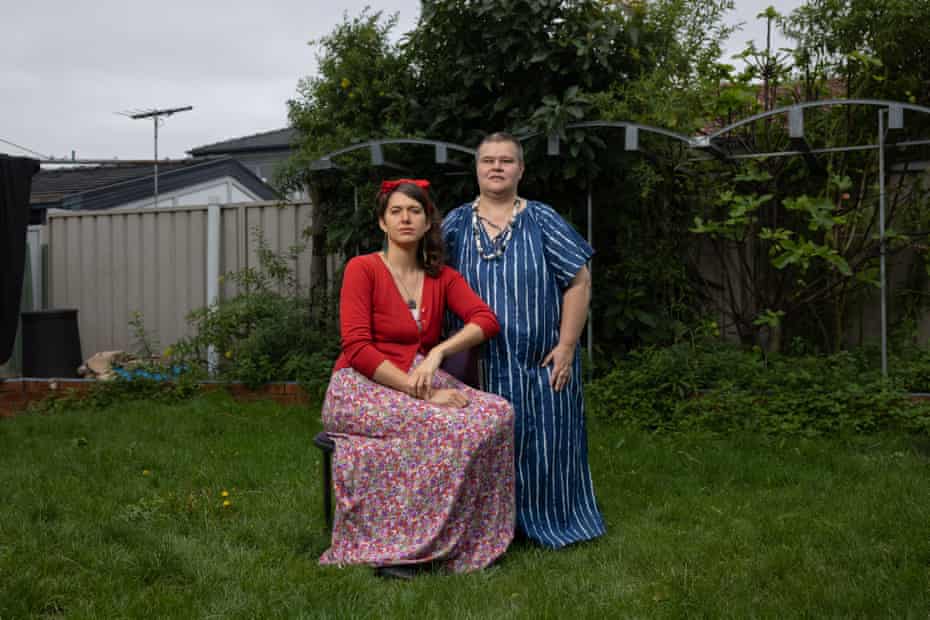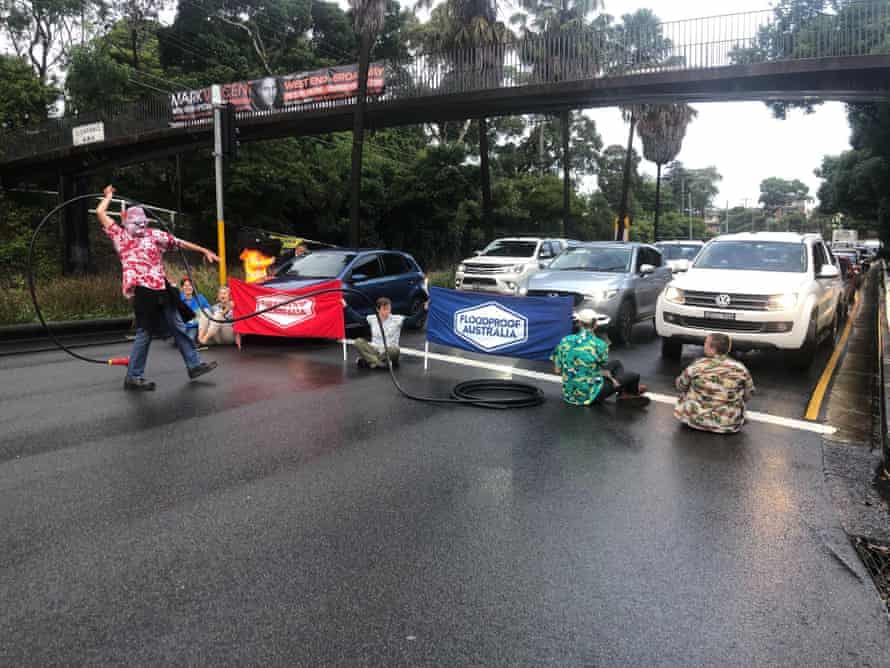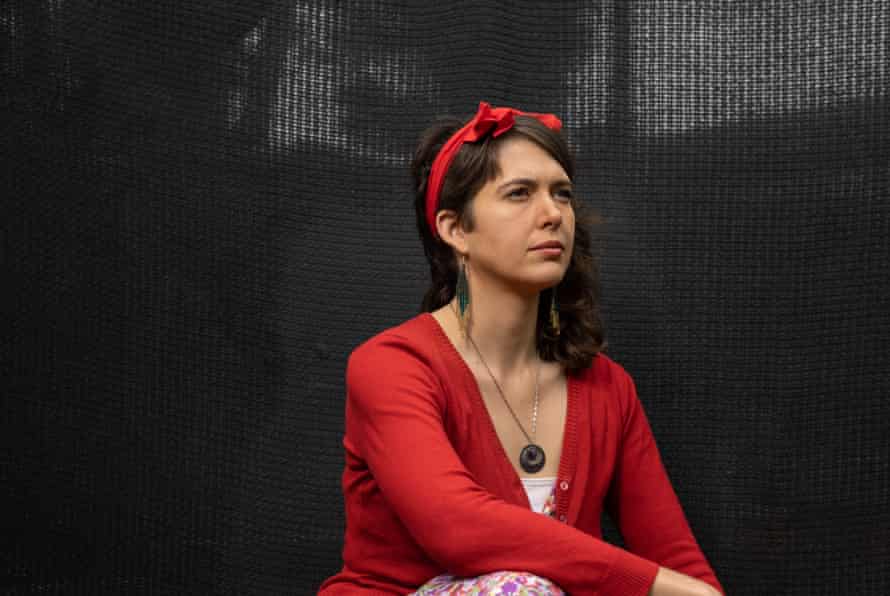
Violet Coco and Sam Noonan are both members of the Fireproof Australia activist group. Photograph: Carly Earl/The Guardian
They have blocked major roads, obstructed traffic on the Sydney Harbour Bridge and been denounced by Dominic Perrottet
Royce Kurmelovs
“[I felt] these, you know, radical, annoying, disruptive, interfering sort of tactics were probably our last chance of doing something,” Noonan says. “I just knew, intuitively, that this is where I needed to be.
“I always said to my husband once we started all this activism that even if all else fails and we can’t save the planet, I want to know that I tried and be able to say to my grandkids, I really did my best, I did my best at the time.”
A few months after Noonan joined Extinction Rebellion, the Black Summer bushfires swept through New South Wales, Victoria and parts of South Australia, changing her life again.
Noonan, who is blind, had to confront the possibility of fleeing her home in the Illawarra, south of Sydney.
“Fires were coming from three directions at once,” Noonan says. “I was there wondering if I could evacuate out of Dapto because I didn’t have anyone who could drive the car and a lot of the train lines were down.”
After the catastrophic event that left 18,000 Australians internally displaced, Noonan joined a new protest group calling themselves Fireproof Australia.


‘Method to their madness’
The hurried NSW legislation in response to the street and industry blockades has been branded a “draconian” attempt to criminalise the right to protest by 40 civil society groups, including the NSW and Act Aboriginal Legal Service, the NSW Council for Civil Liberties, Human Rights Law Centre, Environmental Defenders Office and Australian Democracy Network.
Piero Moraro, a lecturer in criminology at Edith Cowan University who studies civil disobedience, says the right to protest can simply be restrained to “waving flags under the eyes of the police”.
As much as governments and commentators may cast militant or disruptive protest groups as troublemakers and even criminals, Moraro says they can drive change thanks to the “radical flank effect”.
“It is a reference to Martin Luther King,” Moraro says. “One reason why he was successful is that you also had the Black Panthers. White America was faced with the choice to either go with King or face more radical protests.”
Associate prof Hans Baer, an honorary research fellow at the University of Melbourne, says there is a risk disruptive protests will “put off mainstream Australia”, but they are also necessary.
“It’s the more radical people who get the attention that pushes the more middle of the road people to act,” Baer says.
“There may be a method to their madness. So long as it doesn’t hurt people, if it only hurts infrastructure that is doing damage and that in turn hurts a lot of people, well, why not?”
They have blocked major roads, obstructed traffic on the Sydney Harbour Bridge and been denounced by Dominic Perrottet
Royce Kurmelovs
THE GUARDIAN
Sat 9 Apr 2022
It was the re-election of a Coalition government in May 2019 that altered the trajectory of Sam Noonan’s life and politics.
“I didn’t really care about politics until then,” Noonan says. “But then a lightbulb went off, and I kind of went, ‘Well, this is not working, we need to do something.’”
At first the 48-year-old helped organise climate rallies in her region, but it was Extinction Rebellion – the group which caused widespread disruption in London in November 2018 – that captured her attention.
The group members’ willingness to face a strong possibility of being arrested appealed to her, as they appeared to take the catastrophic risk of climate change seriously.
It was the re-election of a Coalition government in May 2019 that altered the trajectory of Sam Noonan’s life and politics.
“I didn’t really care about politics until then,” Noonan says. “But then a lightbulb went off, and I kind of went, ‘Well, this is not working, we need to do something.’”
At first the 48-year-old helped organise climate rallies in her region, but it was Extinction Rebellion – the group which caused widespread disruption in London in November 2018 – that captured her attention.
The group members’ willingness to face a strong possibility of being arrested appealed to her, as they appeared to take the catastrophic risk of climate change seriously.
“[I felt] these, you know, radical, annoying, disruptive, interfering sort of tactics were probably our last chance of doing something,” Noonan says. “I just knew, intuitively, that this is where I needed to be.
“I always said to my husband once we started all this activism that even if all else fails and we can’t save the planet, I want to know that I tried and be able to say to my grandkids, I really did my best, I did my best at the time.”
A few months after Noonan joined Extinction Rebellion, the Black Summer bushfires swept through New South Wales, Victoria and parts of South Australia, changing her life again.
Noonan, who is blind, had to confront the possibility of fleeing her home in the Illawarra, south of Sydney.
“Fires were coming from three directions at once,” Noonan says. “I was there wondering if I could evacuate out of Dapto because I didn’t have anyone who could drive the car and a lot of the train lines were down.”
After the catastrophic event that left 18,000 Australians internally displaced, Noonan joined a new protest group calling themselves Fireproof Australia.

Fireproof Australia taking their first roadblock action on the Princes Highway
in Sylvania, NSW.
Photograph: Fireproof Australia
In recent weeks the group has been grabbing headlines for blocking major roads during the morning peak hour to call for immediate action on climate change, including obstructing traffic on the Sydney Harbour Bridge at least three times.
The NSW government rushed through strict laws to curb the protests, and the premier, Dominic Perrottet, attacked Fireproof Australia for their disruptive tactics.
“This type of behaviour needs to stop,” Perrottet said. “People have the right to protest, people have the right to free speech, we promote that.
“But don’t do it at the expense of people trying to get to and from work, trying to get their kids to school, stopping people earning a living and a wage – that’s what these protests are doing.
“We’ve passed the laws, we’ll throw the book at these people, because their behaviour is completely unacceptable.
“And if you really want to lose support in the community for your cause, keep acting like that.”
‘We tried protesting’
This week the Intergovernmental Panel on Climate Change (IPCC) released its latest comprehensive review, saying it was “now or never” to prevent catastrophic climate change.
Protest groups around the world have been growing more ambitious in response to what they see as an emergency.
Among those that have emerged in the UK are Tyre Extinguishers, which encourages people to deflate the tyres of SUV owners, and Just Stop Oil, which targets oil infrastructure.
Groups such as Fireproof Australia, Floodproof Australia and Blockade Australia are local variations who employ direct action in a campaign of “civil resistance” against governments which they believe aren’t acting fast enough on climate change.
Violet CoCo, a Fireproof Australia member, says the group splintered from Extinction Rebellion in May 2021 to take the protests to a new level.
“Fireproof Australia is designed to be more disruptive and more accessible in that disruption,” CoCo says. “All you need to do is sit down on a road to participate, you don’t need to wear a fancy costume.”
In recent weeks the group has been grabbing headlines for blocking major roads during the morning peak hour to call for immediate action on climate change, including obstructing traffic on the Sydney Harbour Bridge at least three times.
The NSW government rushed through strict laws to curb the protests, and the premier, Dominic Perrottet, attacked Fireproof Australia for their disruptive tactics.
“This type of behaviour needs to stop,” Perrottet said. “People have the right to protest, people have the right to free speech, we promote that.
“But don’t do it at the expense of people trying to get to and from work, trying to get their kids to school, stopping people earning a living and a wage – that’s what these protests are doing.
“We’ve passed the laws, we’ll throw the book at these people, because their behaviour is completely unacceptable.
“And if you really want to lose support in the community for your cause, keep acting like that.”
‘We tried protesting’
This week the Intergovernmental Panel on Climate Change (IPCC) released its latest comprehensive review, saying it was “now or never” to prevent catastrophic climate change.
Protest groups around the world have been growing more ambitious in response to what they see as an emergency.
Among those that have emerged in the UK are Tyre Extinguishers, which encourages people to deflate the tyres of SUV owners, and Just Stop Oil, which targets oil infrastructure.
Groups such as Fireproof Australia, Floodproof Australia and Blockade Australia are local variations who employ direct action in a campaign of “civil resistance” against governments which they believe aren’t acting fast enough on climate change.
Violet CoCo, a Fireproof Australia member, says the group splintered from Extinction Rebellion in May 2021 to take the protests to a new level.
“Fireproof Australia is designed to be more disruptive and more accessible in that disruption,” CoCo says. “All you need to do is sit down on a road to participate, you don’t need to wear a fancy costume.”

Violet Coco, a member of the Fireproof Australia activist group.
Photograph: Carly Earl/The Guardian
They also have different demands. Extinction Rebellion wants governments to declare a climate emergency and rapidly cut emissions to zero by 2025 while Fireproof Australia’s goals are more immediate.
CoCo says the group wants a permanent, Australian-based air tanker fleet to fight bushfires, smoke-proof schools, aged care and disability centres to protect the vulnerable, and an immediate plan to rehome flood and fire survivors.
Some commentators who support urgent action on the climate crisis have criticised direct action tactics as counterproductive, warning they may alienate the very people who need to be persuaded. Writing in the Nine newspapers last month, the social researcher Rebecca Huntley said people who were “disengaged, uncertain or sceptical” were less likely to listen to someone who was making it harder for them to get to work.
“In the qualitative research I have done, groups such as Extinction Rebellion come up in conversation in a very negative way and can be a barrier to talking about global warming and how climate action might actually improve their lives,” Huntley wrote.
But CoCo says every other attempt to get governments to act has failed.
“We tried,” CoCo says. “We tried protesting to the politicians. We’ve tried one-day marches. Nothing happened. And so now we need to escalate these disruptive tactics.”
The group is often associated with Blockade Australia, whose members obstruct physical infrastructure such as rail lines or cranes, although the two groups are separate.
Blockade Australia’s membership is drawn from several campaigns, including Rising Tide, which targeted the coal industry in Newcastle, and anti-Adani protesters from Queensland.
The group’s first major action was obstructing coal trains at Newcastle, the largest coal port in the world in November 2021, prompting an attack from Barnaby Joyce, who said $60m in exports had been lost in one week.
In recent weeks the group has targeted Port Botany in Sydney, Australia’s largest container port, which led to the arrest of Maxim Curmi, who was jailed for four months after he scaled a 60m crane.
Unlike other groups, Blockade Australia has no specific goals. Maddie, a spokesperson who declined to give her surname citing the risk of arrest, says it is focused on “building momentum” as it “doesn’t see any worth in appealing to the goodwill of a system that doesn’t have any”.
They also have different demands. Extinction Rebellion wants governments to declare a climate emergency and rapidly cut emissions to zero by 2025 while Fireproof Australia’s goals are more immediate.
CoCo says the group wants a permanent, Australian-based air tanker fleet to fight bushfires, smoke-proof schools, aged care and disability centres to protect the vulnerable, and an immediate plan to rehome flood and fire survivors.
Some commentators who support urgent action on the climate crisis have criticised direct action tactics as counterproductive, warning they may alienate the very people who need to be persuaded. Writing in the Nine newspapers last month, the social researcher Rebecca Huntley said people who were “disengaged, uncertain or sceptical” were less likely to listen to someone who was making it harder for them to get to work.
“In the qualitative research I have done, groups such as Extinction Rebellion come up in conversation in a very negative way and can be a barrier to talking about global warming and how climate action might actually improve their lives,” Huntley wrote.
But CoCo says every other attempt to get governments to act has failed.
“We tried,” CoCo says. “We tried protesting to the politicians. We’ve tried one-day marches. Nothing happened. And so now we need to escalate these disruptive tactics.”
The group is often associated with Blockade Australia, whose members obstruct physical infrastructure such as rail lines or cranes, although the two groups are separate.
Blockade Australia’s membership is drawn from several campaigns, including Rising Tide, which targeted the coal industry in Newcastle, and anti-Adani protesters from Queensland.
The group’s first major action was obstructing coal trains at Newcastle, the largest coal port in the world in November 2021, prompting an attack from Barnaby Joyce, who said $60m in exports had been lost in one week.
In recent weeks the group has targeted Port Botany in Sydney, Australia’s largest container port, which led to the arrest of Maxim Curmi, who was jailed for four months after he scaled a 60m crane.
Unlike other groups, Blockade Australia has no specific goals. Maddie, a spokesperson who declined to give her surname citing the risk of arrest, says it is focused on “building momentum” as it “doesn’t see any worth in appealing to the goodwill of a system that doesn’t have any”.
‘Method to their madness’
The hurried NSW legislation in response to the street and industry blockades has been branded a “draconian” attempt to criminalise the right to protest by 40 civil society groups, including the NSW and Act Aboriginal Legal Service, the NSW Council for Civil Liberties, Human Rights Law Centre, Environmental Defenders Office and Australian Democracy Network.
Piero Moraro, a lecturer in criminology at Edith Cowan University who studies civil disobedience, says the right to protest can simply be restrained to “waving flags under the eyes of the police”.
As much as governments and commentators may cast militant or disruptive protest groups as troublemakers and even criminals, Moraro says they can drive change thanks to the “radical flank effect”.
“It is a reference to Martin Luther King,” Moraro says. “One reason why he was successful is that you also had the Black Panthers. White America was faced with the choice to either go with King or face more radical protests.”
Associate prof Hans Baer, an honorary research fellow at the University of Melbourne, says there is a risk disruptive protests will “put off mainstream Australia”, but they are also necessary.
“It’s the more radical people who get the attention that pushes the more middle of the road people to act,” Baer says.
“There may be a method to their madness. So long as it doesn’t hurt people, if it only hurts infrastructure that is doing damage and that in turn hurts a lot of people, well, why not?”
No comments:
Post a Comment